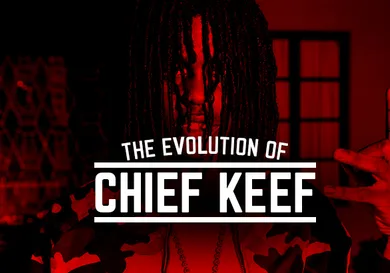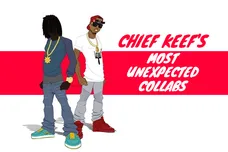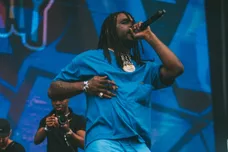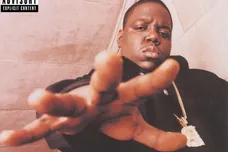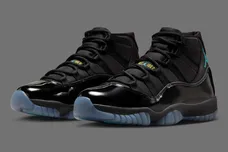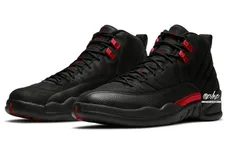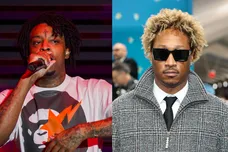This week, Chief Keef caused a stir by releasing two tracks with Andy Milonakis, a comedian who'd formerly rapped alongside RiFF RAFF and Dirt Nasty in the group Three Loco. The man who came up as the poster boy for Chicago's violent drill scene was chilling out a bit and embracing humor with these tracks, or so it seemed. In actuality, the Milonakis co-sign was just the latest in a long line of unexpected and seemingly out-of-character moves by the dude born Keith Cozart.
Getting a jump-start on his rap career by using mom's karaoke machine to record his first rhymes at age 5, Cozart grew up quick on the Chicago's notorious Southside, showing up on his first mixtape at age 14 and fathering his first child at 16. By 17, he had signed a $6 million record deal with Interscope, which would eventually crumble in Fall 2014, leading to Keef parting ways with the label. Since then, his music has taken a turn away from the radio-ready bombast of songs like "Don't Like" and gotten much more unorthodox. Keef's now dropping loosies left and right, not to mention the three projects he's released since last October, and honing on his production chops.
Breaking Keef's career into four parts -- his pre-Interscope days, the Finally Rich era, his last days on the label, and everything else up until yesterday's Sorry 4 The Weight -- we'll take you through the evolution of his music.
unsigned hype
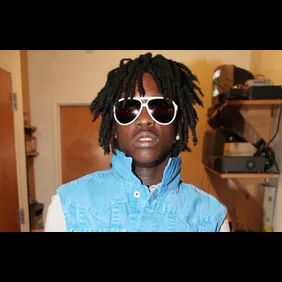
Unsigned Hype
By the time the rest of the world caught on to Keef's music, the violence within was what most people were focusing on, shocked that this young dude was talking about shooters and choppers with such glee in his voice. The truth is, he wasn't always the type to revel in gun talk, as his early tapes reveal a much more happy-go-lucky, if still a little discourteous, Keef.
On Mulah Express, a tape that originally dropped in July 2010, Keef was more likely to proclaim that he was "white boy wasted" and "paper chasing" than he was to talk about gang violence, although he still takes some time to shout-out his "pretty glocks." The beats, primarily produced by DJ Kenn, follow suit. Constructed mostly from bright synths, horns and string presets, they sound somewhat akin to Zaytoven's technicolor take on trap music (the "South Side Shit" beat would almost fit nicely on Future and Zay's Beast Mode).
The Glory Road, another early tape, is even more striking in its cheerful content. "Do It For The Hood" is even almost a little cheesy in its uplifting sound, with Keef sounding akin to a less-practiced Rich Homie Quan on the string-led beat. The instantly-recognizable vocal style that highlights nearly all of his music was there early on, with his garbled enunciation and auto-tune letting us know that despite the stylistic differences, this was still Keef who was rapping.
Things seemed to change for Cozart around the time the aptly-titled Bang dropped in Fall 2011. Spend thirty seconds watching the title track's video (below), and that'll become immediately clear. Bringing out a whole host of homies, including recognizable faces like Lil Durk and Lil Reese, Keef's still celebrating his hood, but with much more menacing overtones. Guns are pantomimed at an almost absurd rate, and the hook consists of just "I'ma let this hammer blow like bang, bang, bang" -- even if the beat wasn't at all ominous (which it totally is), "Bang" paints Keef as a much more dangerous character than his early music did.
The other big change around this time was the level of attention the 16-year-old began attracting, with the "Bang" video racking up millions of views despite its low-budget look and relatively unpolished music. Virtually unnoticed as a mixtape artist with a lighter heart, Keef seemed to only blow up once he began incorporating gun sound ad-libs and darker sonic palettes, which definitely raises some chicken/egg-style questions. Obviously, the neighborhood he grew up in played a role in determining where Keef was headed, but imagine making an uncharacteristically violent track, putting in online, and waking up one day finding that it had gotten something like 50 times the views of your previous work. You're not about to go back to "Do It For The Hood" anytime soon.
Perhaps not so coincidentally, this was also when Cozart began getting in trouble with the law. After a particularly bold incident that involved him pointing a gun at some cops, Keef was sentenced to home confinement at his grandma's house, leading him to devote much more time to music. Long story short: it paid off. Largely due to the tremendous popularity of videos like "3HUNNA" and "I Don't Know Dem," as well as his Back From The Dead tape, Keef started a bidding war between labels in Spring 2012 (even getting a brief reprieve from his confinement to take meetings with Atlantic and Bad Boy in New York), and by June 2012, Interscope had beaten out Cash Money, CTE, and a whole score of others. Just about to turn 17, Keef now had several million to his name and his own imprint.
finally rich
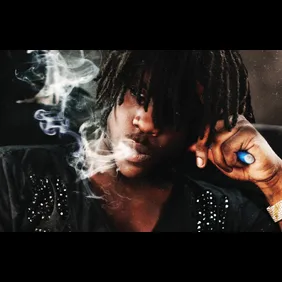
Finally Rich
About a month after Chief Keef inked his lucrative Interscope deal, Back From The Dead cut "I Don't Like" was remastered and released as his first official single. Though still featuring some iconic "bang bang" ad-libs and talk of "taking lifes," the song was a little less abrasive than the rest of the tape, and ended up being Keef's first big crossover hit. But even before the original track hit the airwaves, it caught Kanye West's ear, and he immediately turned it into a big-budget, G.O.O.D. Music affair that became even more popular.
At this point, Keef was somewhat in danger of turning into the one-hit-wonder who gets a big co-sign and then never matches its success, but his next single, "Love Sosa," made sure that would never happen. Still Keef's most popular song on YouTube, the music video has over 40 million views, with that number sharply contrasting with its low-key, D Gaines-shot visuals that basically just feature Keef, SD and Fredo Santana jumping around inside of a house. With D.I.Y. stylings, rudimentary-but-explosive production from Young Chop, and of course, tons of money, Keef created a blueprint for drill artists across the Southside. What's even better, most of the guys who popped off in his wake were affiliates, making him seem even more like the leader of a citywide movement.
In December 2012, Keef's Interscope debut, Finally Rich, saw the light of day. Despite the strength of its singles and some high-profile guest spots, it didn't perform well commercially, and is now often viewed as a cautionary tale for viral rappers looking to sign major label deals. Somehow, the hype surrounding Keef seemed to disintegrate right around album release time, and perhaps due to Interscope's desire to squeeze as many recognizable names onto it as possible, Finally Rich was a much more scattered and inconsistent affair than Bang and Back From The Dead.
What was interesting about the LP was its weirdness. Although he kept it relatively conventional for collabs with Wiz Khalifa, Rick Ross and others, Keef showed a different side on tracks like "Laughin' To The Bank" and "Citgo." He was taken to task by many for his lack of lyrical coherence and, for the most part, actual bars, on these tracks, but their unorthodox sound gained him a cult following that persists to this day. Especially on "Citgo," an ethereal gem produced by an 18-year-old Polish producer Keef discovered when googling "Chief Keef type beats," we got an idea of the direction the drill pioneer was headed.
Label purgatory
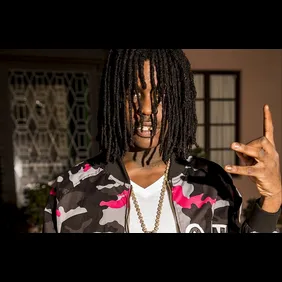
Falling Out With Interscope
Unfortunately, the release of Finally Rich coincided with some more illegal activity from Chief Keef. After fellow Southside rapper Lil JoJo was shot to death, his family claimed that Keef had paid to have him killed, and a disrespectful tweet didn't help his case. Keef never got charged for that one, but would land in some hot water for a parole violation months later. Shamelessly playing up the rapper's violent image, Pitchfork invited him to be interviewed at a shooting range, and after law enforcement caught wind, Keef spent two months in a juvenile detention facility beginning in January 2013. This certainly put a dent in his musical output, as it wasn't until August that he released his next project, the Bang Pt. 2 tape.
This one was generally viewed as less consistent than his early tapes, and was certainly less adventurous than Finally Rich. Having somewhat toned down the violent subject matter for the commercial release, Keef was back to his old ways, rapping about AKs and shotguns with reckless abandon over trappy but generally unimpressive beats. Lean seemed to be a new presence in Keef's life, with frequent shouts-out to dirty Sprite and Actavis being heard across the project, and some have blamed his somewhat lackluster performance on the substance. All of this isn't to say that this period in Keef's life was completely devoid of bangers -- he still shone on cuts like "Where He Get It."
Almighty So, released in October 2013, was a little better mastered and more consistent. Bangers were less of a rarity, but Keef was still spitting through a haze of endless blunts and double-cups, and there wasn't anything that sounded like a single or an out-of-character moment for him. On HNHH, the general consensus was that it mostly consisted of throwaway tracks.
Between the release of Almighty So and Keef's departure from Interscope (almost an entire year), he didn't drop a single project. Many were announced, and individual tracks kept pouring out from Sosa's various online accounts, but it was clear that him and his label weren't on the best terms. A source inside Interscope said they began trying to "subtly disassociate" themselves from the rapper when his legal cases began stacking up around the start of 2013, and that explains why none of the release dates that Keef announced came to fruition. Still, he seemed hellbent on bettering his musical career, as he admitted to Billboard early in 2014 that his last two mixtapes had been "mistakes" and promised that his lean-sipping days were over.
With Keef unable to work with high-profile artists and put out any sort of project, this was certainly one of the low points of his musical career, but the dope cuts were still there if you looked hard enough. Here's one of them.
Finally independent
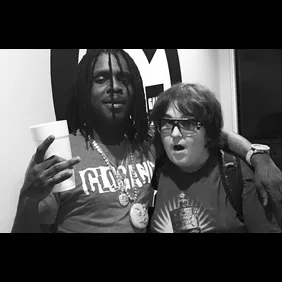
Finally Independent
In October of last year, Keef confirmed that he had parted ways with Interscope, and didn't seem at all disappointed by it. On the contrary, his tweets following the announcement sounded relieved and optimistic, citing his financial independence and ability to release projects on his own terms as reasons for his lack of dismay. It was also around this time when he began dropping tracks that he had produced himself. Much stranger than the Young Chop beats he's most closely associated with, Keef's beats definitely wouldn't have flown on a major label release, so it's fitting that his self-production days began just around the time of his independence. One of the most intriguing of these was "Dear," a track that sounded just as influenced by Spaghetti Western soundtracks as it was by Zaytoven -- check it out below.
Within weeks, we got the long-awaited sequel to 2012's Back From The Dead, which ended up being almost entirely produced by Sosa On The Beat himself. Left to his own devices, Keef's music got less violent, trippier, and more experimental. Still "drill" by association, the songs largely lacked the booming beats associated with that genre, instead favoring barely-there drums and all-consuming melodic atmospheres. When he did fall back into "get whacked with this click-clack" territory, he did it with hooks as goofy as "Where's Waldo" and "I smoke kush like I grow it on a farm." BFTD2 wasn't for everyone, but it saw Keef carving out a personal lane unconcerned with mass appeal and his public image, as well as giving his cult fans a unique full body of work to sink their teeth into.
Nobody was soon to follow, and with it came the Kanye West-assisted title track that had been buzzing on the internet for months. This song was possibly even more shocking than the entirety of the preceding tape, as most people never expected to hear Sosa rapping over a Willie Hutch sample. Although the rest of the production on the album was largely handled by 12Million, and was a little more conventional than Keef's own geeked up beats, it was still less aggressive and more blunted than his pre-2014 music.
The latest chapter in Keef's saga came yesterday, when his Lil Wayne-spoofing Sorry 4 The Weight tape impacted. Opening the tape sounding like Travi$ Scott on "WWYD," Keef chose to go with in-house production from Glo Gang's GGP, DPGGP and Chopsquaddj, whose beats generally fall somewhere in between Keef's own production work and 12Million's more trappy fare. What with with Milonakis' appearance on "Hot Shit," Keef spending half of "Himalayas" telling us the various letters that he puts in words (as in "Bitch I put the C in Cyprus"), and the line "I'm a curry-eating motherfucker," this mixtape is weird as hell. Unlike the scattered mess of Bang Pt. 2 and Almighty So, though, S4TW is intriguing, charismatic and, most importantly, downright fun at times. Keef still has his fair share of haters, but he genuinely seems like he's making an effort to further his career and cover new artistic ground. Just listen to his inspiring intro on "Ten Toes Down."
As has always been the case with Sosa's career, we have no clue where he's headed next, but it's looking more promising now than it has since Finally Rich dropped. With complete independence, Keef seems to have found a comfortable and successful rhythm, and with no legal troubles to speak of in the past twelve months, the wild child Keef of years past seems to have matured and gotten his shit together. At this point, it doesn't seem like he'll ever top his 2012 peak of being remixed by Kanye and seeing "Love Sosa" on the radio, but does it even seem like he wants that now? Sure, some sort of collab with Drake may be on the way, but for now, it sounds like he's content with exploring new sounds and honing his craft, feeding a rabid fanbase with music that's always unpredictable.
Let's not forget that Keith Cozart is still only 19, and having seen more success in his late teenage years than most rappers see in their lives, he's got nearly unlimited space to keep growing. Maybe by the time he's legal drinking age, he'll be collaborating with Lady Gaga or Travis Barker, either making pop smashes or burrowing deeper into the world of underground music. One thing's for sure: we'll be eagerly awaiting whatever he does.
